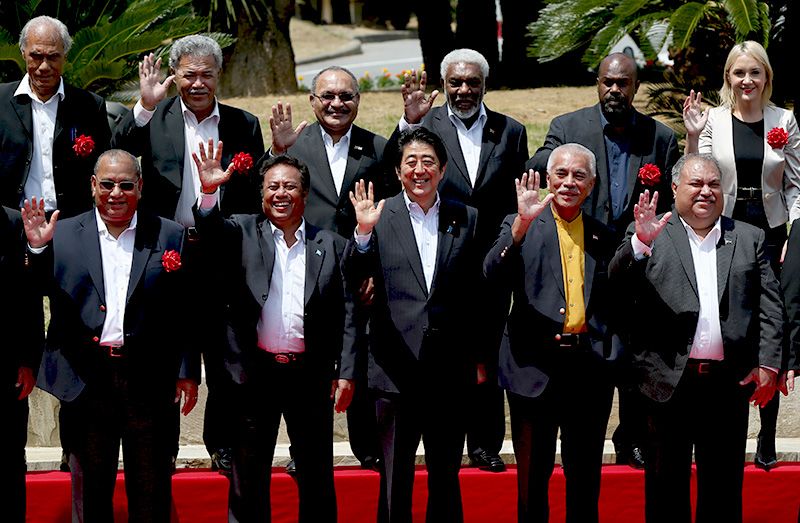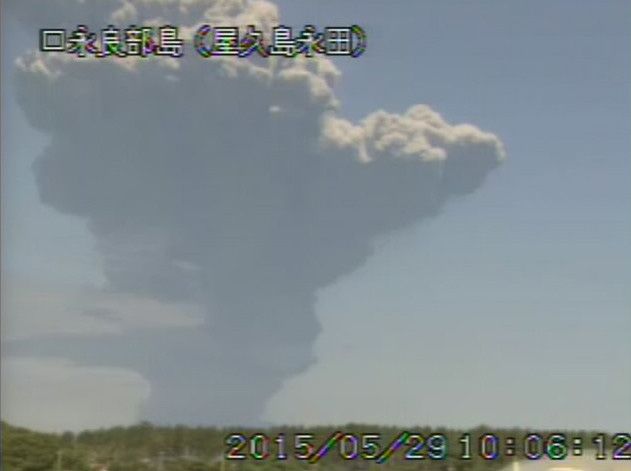Timeline for May 2015
Politics Economy Science Technology Society- English
- 日本語
- 简体字
- 繁體字
- Français
- Español
- العربية
- Русский
2
Kishida Fumio becomes the first Japanese foreign minister to visit Cuba, meeting with President Raúl Castro and former President Fidel Castro.
4
The International Council on Monuments and Sites, a UNESCO advisory panel, recommends Sites of Japan’s Meiji Industrial Revolution for World Heritage status. The 23 sites include Yawata Steelworks, Miike Coal Mine, Mitsubishi’s Nagasaki Shipyard, and Hashima Coal Mine on the island popularly known as Gunkanjima (Battleship Island). South Korea opposes registration as World Heritage due to workers from the Korean peninsula being used in forced labor at seven of the sites.
6
The Japan Meteorological Agency raises the alert level for the volcano Mount Hakone to two on its five-point scale, indicating “Do not approach the crater,” due to increased seismic activity. The economic impact on the popular tourist destination is expected to be significant.
8
Toyota announces a record ¥2.2 trillion profit for fiscal 2014 (ending March 2015), becoming the first Japanese corporation to break the ¥2 trillion barrier. Performance was buoyed by cost cuts, the weak yen, and increased profits in the North American market.
11
The US Department of Defense announces that 10 CV-22 Osprey aircraft will be stationed at Yokota Air Base in suburban Tokyo. Three craft will arrive in 2017, followed by seven more in 2021. This is the first time that Osprey aircraft will be stationed in Japan outside Okinawa Prefecture.
14
The cabinet approves security legislation allowing Japan to exercise the right to collective self-defense and removing geographical restrictions on where its Self-Defense Forces can operate. The government now aims to pass the legislation through parliament.
Sharp reports a record loss of ¥222.3 billion for fiscal 2014 after poor performance in its liquid crystal display, solar cell, and television sectors. At the same time, it presents a new medium-term management plan offering voluntary retirement to 3,500 employees, among other measures.
17
Voters in an Osaka referendum narrowly defeat a bill that would have abolished the municipal assembly and divided the city into five special wards. Mayor Hashimoto Tōru, who proposed the plan, states that he will not run in the next election, scheduled to be held before the end of the year, and will retire from politics. Japan Innovation Party leader Eda Kenji also takes responsibility for the defeat of the motion and resigns; he is replaced by Matsuno Yorihisa.
18
 Figure skater Asada Mao announces she will resume training at a May 18, 2015, press conference in Tokyo. (© Jiji)
Figure skater Asada Mao announces she will resume training at a May 18, 2015, press conference in Tokyo. (© Jiji)
Asada Mao, who won a silver medal in the ladies’ single skating event at the 2010 Winter Olympics in Vancouver, announces her return to training. Following her disappointing sixth-place finish at the 2014 games in Sochi, Asada decided to take a break from training from May last year.
19
The US Department of Transportation announces that major Japanese auto supplier Takata has acknowledged defects in its airbags and agreed to a nationwide recall—the largest ever recall in American history, affecting some 34 million vehicles.
20
The Japan Association of Zoos and Aquariums votes to stop buying dolphins caught during the dolphin hunt at Taiji, Wakayama Prefecture, after its membership was suspended from the World Association of Zoos and Aquariums in April. The ban was based on JAZA’s violation of the international body’s code of ethics on animal welfare.
22
The Pacific Island Leaders Meeting begins in Iwaki, Fukushima Prefecture, with the participation of Japan, Australia, New Zealand, and 14 Pacific island nations. Prime Minister Abe Shinzō pledges more than ¥55 billion in aid over the next three years to deal with the impact of climate change and natural disasters.
 Commemorative photo of Prime Minister Abe (front center) and other leaders at the Pacific Island Leaders Meeting on May 23, 2015, in Iwaki, Fukushima. (© Jiji)
Commemorative photo of Prime Minister Abe (front center) and other leaders at the Pacific Island Leaders Meeting on May 23, 2015, in Iwaki, Fukushima. (© Jiji)
26
Debate over the security legislation approved by the cabinet on May 14 begins in the Diet. Prime Minister Abe points to the increasingly severe security environment, citing North Korean missile and nuclear development and Chinese naval activities in the East China Sea and South China Sea, as a reason to update Japan’s security policy.
27
The Nuclear Regulation Authority approves the restart of Kyūshū Electric Power Company’s Sendai Nuclear Power Plant. The first plant to meet tougher regulations introduced after the accident at the Fukushima Daiichi Nuclear Power Plant in March 2011, Sendai now only needs to clear final operational checks. Reactor 1 is scheduled to restart in late July.
29
 Thick smoke rises from Shindake on the morning of May 29, 2015. Photograph from the Japan Meteorological Agency website.
Thick smoke rises from Shindake on the morning of May 29, 2015. Photograph from the Japan Meteorological Agency website.
The volcano Shindake erupts on the island of Kuchinoerabujima, 90 kilometers off the coast of Kagoshima Prefecture, with a pyroclastic flow reaching as far as the ocean. The Japan Meteorological Agency raises its alert to five on its five-point scale, indicating that the more than 100 residents should evacuate from the island. The peak had previously erupted in August 2014, its first volcanic activity in 34 years.
30
An earthquake of magnitude 8.1 takes place at around 20:23 with its hypocenter 682 kilometers below the surface of the earth to the west of the Ogasawara Islands, which lie around 1,000 kilometers south of Tokyo. Shaking of upper 5 on the Japanese intensity scale is measured in Hahajima in the Ogasawara Islands and Ninomiya, Kanagawa Prefecture. There are no fatalities and no tsunami.
World Heritage earthquake nuclear power Osaka Hashimoto Toru collective self-defense Sharp Toyota osprey Asada Mao volcano Takata dolphins